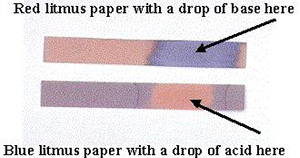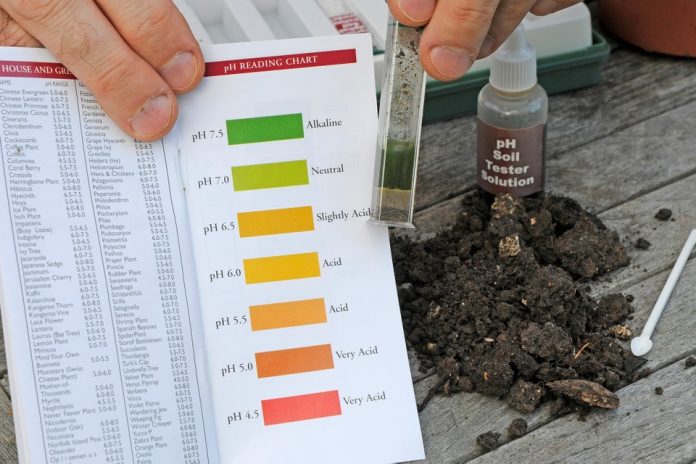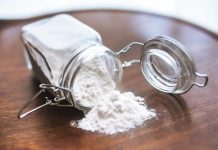With respect to plant growth, the pH of the soil in which the plant grows can have a massive impact on yield, so optimizing the pH in soil is important.
Solutions on the pH-scale shown to be 7 are neutral, so pure water would be neutral.
Solutions on the pH scale below 7 are acidic-for example, cider vinegar is around 4 on the scale and stomach acid (hydrochloric acid) is about 2-3.
In the pH scale, solutions above 7 are alkaline – bleach is about 13 on the scale, and a baking soda solution about 9.
Testing the pH of a Solution
There are a variety of ways to check the pH of a solution. It’s a case of exactly how specific you need to be. You need more of a ballpark than precision as regards growing plants. You can use the following methods to test pH to varying degrees of accuracy. Once it comes to when the SHTF, you can plan by setting aside some of the approaches that are currently available and only using the natural approach when you run out.
Litmus paper:

Blue paper —-à (becomes) red in acid
Red paper —-à (becomes) blue in alkaline


Universal indicator: This comes in two separate ways, paper and a liquid. Like Litmus, it covers the whole pH spectrum in one go. This is composed of a mixture of chemical components that display a change in color under various pH conditions. The color change ranges across the range from red through to purple in the paper type, which also appears in the form of a box of sticks. You wet the stick with your solution then hold the stick against a chart on the box, which gives you the pH of the solution you are testing. Generic indicator solution variant works similarly, changing color depending on the pH.
Related: What is Hydroponic Gardening?
Natural pH Indicator
If you don’t have any commercial pH indicators to hand, you can get a general idea of soil pH by using natural substances. Here are a few ideas:
- Beet juice will change from red to blue/purple if you add an alkaline solution.
- Baking soda will fizz if you add an acidic solution to it.
- Red cabbage boiled up in water – the water will show a color change from red (acid), to purple (neutral), through to a green/yellow (alkaline) when you add a solution to it.
Testing the pH in Soil
To test the pH of your soil, add some soil to a vial. Add some water and give it a good shake. Leave it to stand for a few minutes, letting the soil settle. Use the water (decanted) to test the pH.
Plants and pH
The reason pH in plant growth is also important is because the pH in soil determines how easily other nutrients dissolve in it. Or put it another way, pH influences solubility directly. Thus, having the correct pH of your soil solution will significantly affect plant yield, such as fruit and vegetables.
The problem is that surroundings affect soil pH. For example, if your area’s rain is very acidic, i.e. has dissolved sulfur compounds in it, or if you have ion-contaminated water, such as potassium and magnesium, the resulting soil pH would be affected. We also see very acidic soils where intensive cultivation has been taking place, using synthetic fertilizers. It maybe we inherit some pretty bad soil from which to work our magic.
There are 13 essential elements that are required to keep the plants safe and yield well. These nutrients need to get taken up into the plant after being dissolved into the soil in solution form. We must therefore ensure that they dissolve and that low pH soils can adversely affect the solubility of these crucial elements.
Related: 47 Gardening Hacks
How to Adjust the pH in Soil
The optimal pH of soil is about neutral, so we are thinking about the ranges 6.5-7.5. The nutrients plants need to grow at this level of acidity are more available to them as they dissolve optimally. Low acidity can cause nutrients, such as calcium and magnesium, to become too soluble and leach away from the plants. When you reach the alkaline environment, nutrients such as phosphorus, iron and manganese are trapped into certain compounds, and they are not available to the plants.
If you are checking the pH of your soil outside the neutral zone, you can make changes to get it back inside.
NOTE: Don’t adjust the pH of fertilizers, compost or manure.
Soil Too Acidic (pH in soil bellow 6)
When the soil falls below pH 6, an alkaline content would need to be added to move it back to the neutral zone. The most common way to do this is to ‘lime’ the soil. Garden lime is an alkaline Calcium carbonate. You may purchase this as a commercial product, or you can use calcified seaweed or ground chalk as an alternative. Another garden lime variant is dolomite lime which contains magnesium. A form of lime is used when you are conscious that you need extra magnesium in your soil.
The best time to add this to the soil is in the winter before planting out. Dig half of the lime in the dirt, then sprinkle over the rest.
You can work out how much to add by running your own tests.
- Take a portion of pH-tested soil in a bucket.
- Add a small amount of the lime to the soil and dig it in (take note of the amount of lime as you’ll need it later).
- Now re-test the pH of the soil
- If it’s still acidic, add a little more lime; if it’s too alkaline do the test again, using less lime
- Once you have your amount of lime added to get the neutral pH you can approximately calculate how much you’ll need for your planting area.
As a rule of thumb, if your original soil pH is 5.5 you’ll need around 25 ounces per square meter of soil, but this is also dependent on the soil type, e.g. sandy, chalky, etc.
Soil Too Alkaline (pH in soil above 7)
There are a few products you can use to adjust the pH in soil downwards:
Sulfur
Adding sulfur to soil to acidify it is a slow process. I used this method to grow bilberries, a plant which really likes acid soils. Usually, you wouldn’t want bilberries to make the soil as acidic as it needs, but the idea is the same. Apply finely ground sulfur to acidify the soil, and lose it in the water. It takes time for sulfur to become active, because bacteria must first transform it. Using it even in colder months, as winter slows down any bacterial activity.
Aluminum Sulfate
This needs small amounts to make a big pH change, so use sparingly and carefully. If you end up with acidic soil, you’ll lose nutrients.
Iron Sulfate
This has the same effect as aluminum sulfate but to get the same pH change, you need bigger quantities. Replace it with phosphate fertilizer, as phosphate can be leached.
To work out how much of the acid compound to apply to your soil, you can use the same type of test shown above. But in general, it will take time to add sulfur to take effect so be prepared for it.





















